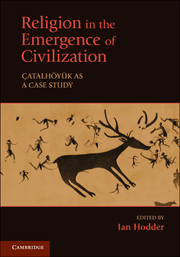Book contents
- Frontmatter
- Contents
- List of Figures and Tables
- Contributors
- 1 Probing religion at Çatalhöyük
- 2 The symbolism of Çatalhöyük in its regional context
- 3 Spiritual entanglement
- 4 Coding the nonvisible
- 5 Modes of religiosity at Çatalhöyük
- 6 Is there religion at Çatalhöyük…or are there just houses?
- 7 History houses
- 8 Marked, absent, habitual
- 9 Temporalities of “religion” at Çatalhöyük
- 10 The Neolithic cosmos of Çatalhöyük
- 11 Magical deposits at Çatalhöyük
- 12 Conclusions and evaluation
- Index
- References
4 - Coding the nonvisible
Epistemic limitations and understanding symbolic behavior at Çatalhöyük
Published online by Cambridge University Press: 05 June 2012
- Frontmatter
- Contents
- List of Figures and Tables
- Contributors
- 1 Probing religion at Çatalhöyük
- 2 The symbolism of Çatalhöyük in its regional context
- 3 Spiritual entanglement
- 4 Coding the nonvisible
- 5 Modes of religiosity at Çatalhöyük
- 6 Is there religion at Çatalhöyük…or are there just houses?
- 7 History houses
- 8 Marked, absent, habitual
- 9 Temporalities of “religion” at Çatalhöyük
- 10 The Neolithic cosmos of Çatalhöyük
- 11 Magical deposits at Çatalhöyük
- 12 Conclusions and evaluation
- Index
- References
Summary
I
For scientists deeply embedded in archaeological and anthropological work, it might seem unusual, if not rather strange, that someone with a theological or religious perspective might be interested in the Middle Eastern Neolithic. However, in my recent work on possible interdisciplinary connections between theology and palaeoanthopology/archaeology, I argued that an integrative praxis for ‘theology and the sciences’ can be found in a dialogue that proceeds from the highly contextual to the transversal as we pick up threads from different disciplinary discourses and weave them into an emerging pattern that transcends strict disciplinary boundaries (van Huyssteen 2006). I have also argued that the standard ‘theology and science’ dialogue has woefully neglected the importance of palaeoanthropology and archaeology for understanding human origins and human nature in general. And although I will not repeat my argument here, I will presuppose that philosophically there are in fact remarkable methodological links between a postfoundationalist approach to theology and some of the important voices in contemporary palaeoanthropology/archaeology today (van Huyssteen 2006). For this reason these sciences, specifically palaeoanthropology and archaeology, by focusing on human origins and modern human behavior, may turn out to intersect in exciting ways with theological concerns and thus help to redirect theological understandings of what it means to return to the prehistoric past and try to come to grips with the very fact of our humanness.
Against this background I believe that in any attempt to understand the Middle Eastern Neolithic, the Upper Palaeolithic in western Europe will provide at least an initial, valuable background for understanding symbolic behavior in the Middle Eastern Neolithic and, quite specifically, the culture of Çatalhöyük. Here too, as in the dark caves of western France, we have to wonder if it makes any sense to ask about the ‘meaning’ of prehistoric imagery or, even more challenging, what might have made the artifacts, wall paintings, sculpture, bucrania and house burials meaningful for the people of Çatalhöyük. In Catalhöyük's array of paintings, sculptures and burials within which bulls, predatory birds and leopards are so prominent, the evidence suggests that the economic changes that led from hunting and gathering to farming were intimately related to religious ideologies. Steven Mithen has correctly concluded that it may be nearly impossible to reconstruct these prehistoric religious ideologies in any meaningful sense (Mithen 2004). Mithen has also argued, however, that an adequate theory of prehistoric religion or modes of religiosity (cf. Whitehouse 2004) can in fact enrich our interpretations of specific aspects of the archaeological record, make some interpretations more plausible than others and help us identity previously unrecognized causal links between religious practices and political structures. Therefore, although it is unlikely that archaeological evidence can provide a formal test for anthropological theories of religion, it can provide longer-term perspectives on how religiosity develops in relation to economy and society (Mithen 2004: 19). It is in this sense that I too want to argue that the embeddedness of religious themes present at Çatalhöyük must be located within the broader context of prehistoric religion.
Information
- Type
- Chapter
- Information
- Religion in the Emergence of CivilizationÇatalhöyük as a Case Study, pp. 99 - 121Publisher: Cambridge University PressPrint publication year: 2010
References
Accessibility standard: Unknown
- 4
- Cited by
